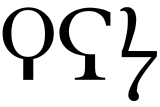Koppa (letter) facts for kids
 |
|||
Quick facts for kids Greek alphabet |
|||
|---|---|---|---|
| Αα | Alpha | Νν | Nu |
| Ββ | Beta | Ξξ | Xi |
| Γγ | Gamma | Οο | Omicron |
| Δδ | Delta | Ππ | Pi |
| Εε | Epsilon | Ρρ | Rho |
| Ζζ | Zeta | Σσ | Sigma |
| Ηη | Eta | Ττ | Tau |
| Θθ | Theta | Υυ | Upsilon |
| Ιι | Iota | Φφ | Phi |
| Κκ | Kappa | Χχ | Chi |
| Λλ | Lambda | Ψψ | Psi |
| Μμ | Mu | Ωω | Omega |
| Other letters | |||
| Ϝϝ | Digamma | Ϟϟ | Koppa |
| Ϛϛ | Stigma | Ϡϡ | Sampi |
| Ͱͱ | Heta | Ϸϸ | Sho |
| Ϻϻ | San | ||
Koppa (also spelled qoppa) was an old letter in the Greek alphabet. It looked like Ϙ or ϙ. This letter came from an even older letter called Phoenician Qoph. Today, Koppa is mostly used as a number sign, looking like ϟ.
Koppa was once used to make a "k" sound, similar to the letter "Q" in English words like "queen." However, over time, another Greek letter called Kappa (Κ) became more common for this sound. Because of this, Koppa stopped being used as a regular letter in the Greek alphabet.
Koppa as a Number
Even though Koppa is not a letter anymore, it is still very important! It is used as a number in the system of Greek numerals. In this system, Koppa stands for the number 90. Its shape changed a little bit when it became a number symbol.
Koppa's Legacy
Koppa has had a big impact on other alphabets too. The Latin letter Q, which we use in English today, actually came from Koppa! It also influenced the Cyrillic alphabet, which is used in languages like Russian. In Cyrillic, there's a number sign called Koppa that looks similar and also stands for 90.
Images for kids
-
Corinthian hemiobol coin. The front shows Pegasus with Koppa below, for Corinth. The back shows Aphrodite wearing a sakkos headband.



